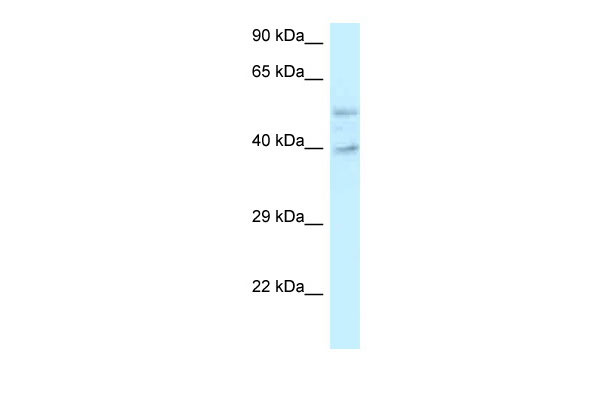GRINL1A antibody - C-terminal region
Rabbit Polyclonal Antibody
- SPECIFICATION
- CITATIONS
- PROTOCOLS
- BACKGROUND

Application
| WB |
|---|---|
| Primary Accession | P0CAP2 |
| Other Accession | NM_015532, NP_056347 |
| Reactivity | Human, Mouse, Rat, Rabbit, Bovine, Guinea Pig, Dog |
| Predicted | Human, Mouse, Rat, Rabbit, Pig, Bovine, Guinea Pig, Dog |
| Host | Rabbit |
| Clonality | Polyclonal |
| Calculated MW | 40kDa |
| Gene ID | 81488 |
|---|---|
| Alias Symbol | DKFZp586F1918, GCOM1, Gdown, Gdown1, GRINL1A |
| Other Names | DNA-directed RNA polymerase II subunit GRINL1A, DNA-directed RNA polymerase II subunit M, Glutamate receptor-like protein 1A, POLR2M, GRINL1A |
| Format | Liquid. Purified antibody supplied in 1x PBS buffer with 0.09% (w/v) sodium azide and 2% sucrose. |
| Reconstitution & Storage | Add 50 ul of distilled water. Final anti-GRINL1A antibody concentration is 1 mg/ml in PBS buffer with 2% sucrose. For longer periods of storage, store at 20°C. Avoid repeat freeze-thaw cycles. |
| Precautions | GRINL1A antibody - C-terminal region is for research use only and not for use in diagnostic or therapeutic procedures. |
| Name | POLR2M |
|---|---|
| Synonyms | GRINL1A |
| Function | [Isoform 1]: Appears to be a stable component of the Pol II(G) complex form of RNA polymerase II (Pol II). Pol II synthesizes mRNA precursors and many functional non-coding RNAs and is the central component of the basal RNA polymerase II transcription machinery. May play a role in the Mediator complex-dependent regulation of transcription activation. Acts as a negative regulator of transcriptional activation; this repression is relieved by the Mediator complex, which restores Pol II(G) activator-dependent transcription to a level equivalent to that of Pol II. |
| Cellular Location | [Isoform 1]: Nucleus. |
| Tissue Location | Detected in adult an fetal brain. Detected in heart, kidney, skeletal muscle, small intestine, lung, prostate and testis. |

Thousands of laboratories across the world have published research that depended on the performance of antibodies from Abcepta to advance their research. Check out links to articles that cite our products in major peer-reviewed journals, organized by research category.
info@abcepta.com, and receive a free "I Love Antibodies" mug.
Provided below are standard protocols that you may find useful for product applications.
References
Roginski R.S.,et al.Cytogenet. Cell Genet. 93:143-144(2001).
Roginski R.S.,et al.Genomics 84:265-276(2004).
Ota T.,et al.Nat. Genet. 36:40-45(2004).
Zody M.C.,et al.Nature 440:671-675(2006).
Mural R.J.,et al.Submitted (JUL-2005) to the EMBL/GenBank/DDBJ databases.
If you have used an Abcepta product and would like to share how it has performed, please click on the "Submit Review" button and provide the requested information. Our staff will examine and post your review and contact you if needed.
If you have any additional inquiries please email technical services at tech@abcepta.com.













 Foundational characteristics of cancer include proliferation, angiogenesis, migration, evasion of apoptosis, and cellular immortality. Find key markers for these cellular processes and antibodies to detect them.
Foundational characteristics of cancer include proliferation, angiogenesis, migration, evasion of apoptosis, and cellular immortality. Find key markers for these cellular processes and antibodies to detect them. The SUMOplot™ Analysis Program predicts and scores sumoylation sites in your protein. SUMOylation is a post-translational modification involved in various cellular processes, such as nuclear-cytosolic transport, transcriptional regulation, apoptosis, protein stability, response to stress, and progression through the cell cycle.
The SUMOplot™ Analysis Program predicts and scores sumoylation sites in your protein. SUMOylation is a post-translational modification involved in various cellular processes, such as nuclear-cytosolic transport, transcriptional regulation, apoptosis, protein stability, response to stress, and progression through the cell cycle. The Autophagy Receptor Motif Plotter predicts and scores autophagy receptor binding sites in your protein. Identifying proteins connected to this pathway is critical to understanding the role of autophagy in physiological as well as pathological processes such as development, differentiation, neurodegenerative diseases, stress, infection, and cancer.
The Autophagy Receptor Motif Plotter predicts and scores autophagy receptor binding sites in your protein. Identifying proteins connected to this pathway is critical to understanding the role of autophagy in physiological as well as pathological processes such as development, differentiation, neurodegenerative diseases, stress, infection, and cancer.


